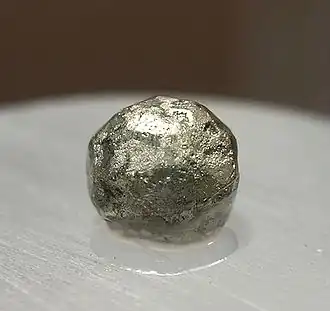Moschellandsbergite
| Moschellandsbergite | |
|---|---|
 | |
| General | |
| Category | Metals and intermetallic alloys |
| Formula | silver amalgam, Ag2Hg3 |
| IMA symbol | Mlb[1] |
| Strunz classification | 1.AD.15d |
| Crystal system | Isometric |
| Crystal class | Tetartoidal (23) (same H-M symbol) |
| Space group | I23 |
| Unit cell | a = 10.04 Å, Z = 10 |
| Identification | |
| Color | white, tarnishes grey |
| Cleavage | brittle |
| Mohs scale hardness | 3.5 |
| Luster | metallic |
| Specific gravity | 13.48 |
| References | [2][3][4][5] |
Moschellandsbergite is a rare isometric mineral made up of a silver-white amalgam of mercury and silver with the chemical makeup Ag2Hg3.
It was first described in 1938 and named after Moschellandsberg Mountain near Obermoschel, Rhineland-Palatinate, Germany.[4][6] It is considered a low-temperature hydrothermal mineral which occurs with metacinnabar, cinnabar, mercurian silver, tetrahedrite–tennantite, pyrite, sphalerite and chalcopyrite.[3]
References
- ^ Warr, L.N. (2021). "IMA–CNMNC approved mineral symbols". Mineralogical Magazine. 85 (3): 291–320. Bibcode:2021MinM...85..291W. doi:10.1180/mgm.2021.43. S2CID 235729616.
- ^ Mineralienatlas
- ^ a b Mineral Handbook
- ^ a b Mindat
- ^ Webmineral
- ^ American Geological Institute (1997). Dictionary of Mining, Mineral, and Related Terms. Alexandria, Virginia: Birkhäuser. p. 356. ISBN 0-922152-36-5.